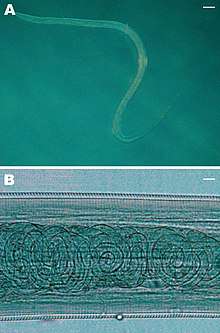Thelazia
| Thelazia | |
|---|---|
 | |
| Thelazia callipaeda female[1] | |
| Scientific classification | |
| Kingdom: | Animalia |
| Phylum: | Nematoda |
| Class: | Secernentea |
| Order: | Spirurida |
| Family: | Thelaziidae |
| Genus: | Thelazia Bosc, 1819 |
| Species | |
|
See text | |
Thelazia is a genus of nematode worms which parasitize the eyes and associated tissues of various bird and mammal hosts, including humans.[2] They are often called "eyeworms", and infestation with Thelazia species is referred to as "thelaziasis" (occasionally spelled "thelaziosis"). Adults are usually found in the eyelids, tear glands, tear ducts, or the so-called "third eyelid" (nictitating membrane). Occasionally, they are found in the eyeball itself, either under the conjunctiva (the membrane that covers the white part of the eye) or in the vitreous cavity of the eyeball.[3] All species of Thelazia for which the life cycle has been studied are transmitted by species of Diptera (flies) which do not bite, but which feed on tears.
Representative species
- Thelazia anolabiata (Molin, 1860)
- Definitive hosts: Andean cock-of-the-rock (Rupicola peruviana) and many other Brazilian birds[4]
- Intermediate hosts: Not known
- Distribution: South America
- Thelazia bubalis Ramanujachari and Alwar, 1952
- Definitive hosts: Water buffalo
- Intermediate hosts: Not known
- Distribution: India
- Thelazia californiensis Price, 1930
- Definitive hosts: Dog (Canis lupus familiaris), cat (Felis catus), occasionally human (Homo sapiens), domestic sheep (Ovis aries), mule deer (Odocoileus hemionus), coyote (Canis latrans) and American black bear (Ursus americanus).
- Intermediate hosts: Lesser house fly (Fannia canicularis) and Fannia benjamini
- Distribution: Western North America
- Thelazia callipaeda Railliet & Henry, 1910 (sometimes called "Oriental eyeworm")
- Definitive hosts: Typically reported from dog (Canis familiaris), cat (Felis catus), and occasionally reported from wolf (Canis lupus), raccoon dog (Nyctereutes procyonoides), red fox (Vulpes fulva), European rabbit (Oryctolagus cuniculus). Over 250 cases of T. callipaeda infestation in humans have been reported thus far.[5]
- Intermediate hosts: Fruit flies (Amiota (Phortica) variegata in Europe, and Phortica okadai in China)
- Distribution: Asia and Europe
- Thelazia erschowi Oserskaja, 1931
- Definitive hosts: Pig (Sus domesticus)
- Intermediate host: Not known
- Distribution: Post-Soviet states
- Thelazia gulosa (Railliet & Henry, 1910)
- Definitive hosts: Yak (Bos grunniens) and other cattle (Bos taurus), and rarely human (Homo sapiens)
- Intermediate hosts: Face fly (Musca autumnalis) in Europe and North America, Musca larvipara in the Ukraine, Musca vitripennis in Crimea, and Musca amica in the Far East
- Distribution: Asia, Europe, and North America
- Thelazia lacrymalis (Gurlt, 1831)
- Definitive hosts: Horse (Equus caballus) and cattle (Bos taurus)
- Intermediate hosts: Face fly (Musca autumnalis) and Musca osiris
- Distribution: Asia, Europe, Middle East, North America and South America
- Thelazia leesei Railliet & Henry, 1910
- Definitive hosts: Dromedary (Camelus dromedarius) and Bactrian camel (Camelus bactrianus)
- Intermediate hosts: Flies (Musca lucidulus)
- Distribution: Post-Soviet states and India
- Thelazia rhodesii (Desmarest, 1828)
- Definitive hosts: mainly bovids, cattle (Bos taurus), water buffalo (Bubalus bubalis), zebu (Bos indicus), bison (Bison bonasus), and sometimes horse (Equus caballus), domestic sheep (Ovis aries), dromedary (Camelus dromedarius), and goat (Capra hircus)
- Intermediate hosts: Face fly (Musca autumnalis, Musca larvipara, and Musca sorbens)
- Distribution: Africa, Asia, and Europe
- Thelazia skrjabini Erschow, 1928
- Definitive hosts: Cattle (Bos taurus) and yak (Bos grunniens)
- Intermediate hosts: Face fly (Musca autumnalis), Musca vitripennis, and Musca amica
- Distribution: Europe and North America
References
- ↑ This image is from the article: Otranto, D. and M. Dutto (2008) "Human thelaziasis, Europe." Emerging Infectious Diseases 14(4):647-649. The journal Emerging Infectious Diseases is published by the Centers for Disease Control, a US government agency.
- ↑ Otranto, D. and D. Traversa (2005) "Thelazia eyeworm: An original endo- and ecto-parasitic nematode." Trends in Parasitology 21(1):1-4.
- ↑ Xue, C., N. Tian, and Z. Huang (2007) "Thelazia callipaeda in human vitreous." Canadian Journal of Ophthalmology 42(6):884-885.
- ↑ de Oliveira Rodrigues, H. (1992) "Thelazia anolabiata (Molin, 1860) Railliet & Henry, 1910 (Nematoda: Thelazioidea), a new host record and systematic considerations." Memórias do Instituto Oswaldo Cruz 87(Suppl 1):217-222.
- ↑ Koyama, Y., A. Ohira, T. Kono, T. Yoneyama, and K. Shiwaku (2000) "Five cases of thelaziasis." British Journal of Ophthalmology 84(4):441-442. (Note: This pdf includes pp. 439-440 in addition to the cited article.)